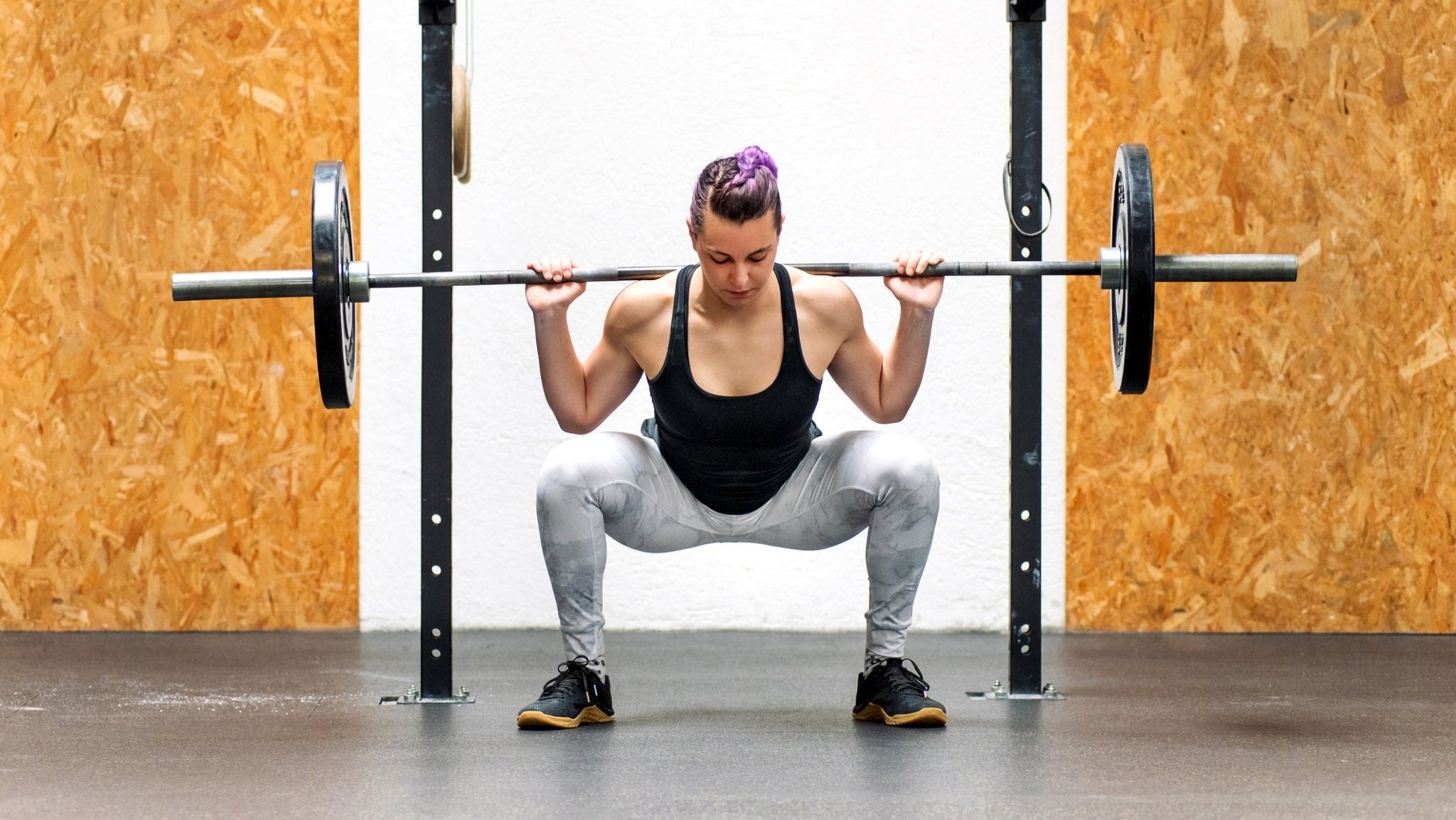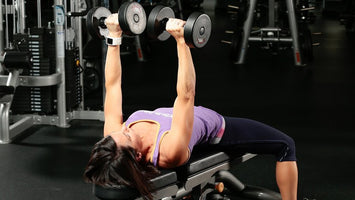
How to Wear a Weightlifting Belt When Performing a Back Squat
The back squat is a staple in strength training routines. It's a compound exercise that recruits multiple muscle groups, which makes it an effective way to build strength and muscle mass.
However, it's crucial to use the right equipment and techniques to maximize the benefits and minimize the risk of injury. One such piece of equipment is the weightlifting belt.
When used correctly, a weightlifting belt can:
-
Increase intra-abdominal pressure,
-
Reduce spinal stress and
-
Boost muscle activation in your legs and core.
However, improperly wearing the belt could limit its benefits or lead to bad habits. Whether you're aiming to break through a plateau or simply improve your form, learning how to wear a belt the right way is crucial for maximizing your squats. This article will guide you on how to wear a weightlifting belt when performing a back squat. Let's get started!
Understanding the Role of a Weightlifting Belt
Before we dive into the specifics of wearing a weightlifting belt, it's essential to understand its role in your routines.
Contrary to popular belief, a weightlifting belt isn't directly designed to support your back. Instead, it serves to increase intra-abdominal pressure, which in turn stabilizes your spine. You achieve this by taking a deep breath (the Valsalva maneuver) and pushing your abdominal wall against the belt. This process creates a rigid core, reduces the stress on the spine, and allows you to lift heavier weights safely.
However, a weightlifting belt isn't a magic tool that instantly improves lifting performance. It's not a substitute for proper form and technique. Also, it's not necessary for all lifts or all lifters. It's most beneficial for heavy, compound lifts like squats, deadlifts, and overhead presses and unnecessary for isolation exercises or exercises that don't place significant stress on the spine. When you’re looking for top-quality and durable gear for squats, check out prices for premium lifting belts for the perfect blend of support and stability.
Why Use a Weightlifting Belt for Back Squats?
A weightlifting belt enhances performance and safety during back squats by stabilizing the core and reducing spinal stress. It effectively increases intra-abdominal pressure, allowing you to lift heavier weights with better form and decreased injury risk. Other benefits are:
How to Choose the Right Weightlifting Belt
Selecting the proper belt for your back squats exercises depends on its design, material, and functionality. A good belt should be durable, fit snugly, and provide consistent support throughout your lifts. Here are some essentials to look out for:
-
Width:
A standard option for squats is a belt with a consistent width, ideally 4 inches, to offer balanced support. Wider belts may feel restrictive or affect movement, especially if you have a shorter torso—and vice versa.
-
Thickness:
Consider your lifting intensity and experience. Are you a powerlifter or into strength training? Most belts sold online are either 10mm or 13mm, so be sure to check that the thickness supports your workout.
-
Closure System:
Weightlifting belts come in different closure systems – prong, lever, and velcro. Prong belts are secure and easily adjustable during exercises. Lever belts are more flexible, but you'll need tools to adjust the tightness. More details below.
Read more: How to choose the right size for your weightlifting belt.
What Types of Belts Are Available?
Weightlifting belts come in different styles, materials, and closure systems, each catering to specific preferences and fitness goals. Here's a brief breakdown of the major types:
Material
There are two main types of materials for weightlifting belts:
-
Leather Belts :
These belts are mostly made from high-quality suede or full-grain leather. They are rigid, durable, and offer excellent stability. They are also perfect for heavy squats, deadlifts, and powerlifting movements.
-
Nylon Belts :
Nylon belts are more flexible and lightweight, which is why they're used for Olympic lifts, CrossFit, and dynamic movements that require mobility.
For lifters seeking a unique fit that complements their squat routine, shop custom belt tailored precisely to your needs.
Closure System
There are three (3) main options for closure systems:
-
Single-Prong and Double-Prong Belts :
Secure and adjustable but require some time to fasten and remove. Double-prong belts can be slightly more challenging to adjust compared to single-prong.
-
Lever Belts :
Lever belts are popular among powerlifters because they are quick to put on and take off. They offer a tight fit, but you need a screwdriver to adjust the tightness.
-
Velcro and neoprene Belts :
Velcro belts are lightweight – compared to other options listed above. They're equally easy to wear and use.
How to Determine the Correct Size for Your Belt?
To find the right fit for your weight belt:
-
Measure Your Waist with a tape measure around your natural waistline. Don't suck in or bend over! Also, take measurements of the clothing you wear during workouts.
-
Check Manufacturer Guidelines. Brands always provide sizing charts for their belts. Select a size that places you in the mid-range of the adjustments.
-
Test the Fit. Remember, the belt should be snug enough to support intra-abdominal bracing but not so tight that it restricts breathing or circulation.
-
Consider Adjustability. Lever and pronged belts allow size adjustments, so you can choose this option if you intend to lift heavier weights in the future.
How to Wear a Weightlifting Belt
Wearing a weightlifting belt improves your core stability and safety during back squats. However, you need proper positioning, fit, and clothing choices to maximize your weightlifting belts:
How to Position the Belt Correctly?
The first step in wearing a weightlifting belt is determining where to position it on your torso. This can vary depending on your body type and the lift you're performing.
For the back squat, position the weightlifting belt across your belly button or slightly above. Keep it horizontal and parallel to the floor, avoiding upward or downward angles. Placing the belt too high can limit your breathing and reduce the effectiveness of the Valsalva maneuver. If it's too low, it can interfere with your hip hinge, a critical movement for proper squat form.
Adjust the belt's position until it's comfortable and doesn't pinch or restrict movement. To test its optimal placement, perform a few bodyweight squats. If it impedes depth or causes discomfort, reposition it slightly higher or lower until it's ideal for your body type. It’s crucial to know when to start using a lifting belt so you can develop proper technique before adding extra support.
How Tight Should the Belt Be?
Once you've positioned the belt, the next step is to tighten it.
The belt should be tight enough to provide support but not so tight that it restricts your breathing or causes discomfort. A good rule of thumb is to fit your hand between the belt and your stomach. This allows enough room for the expansion of your abdomen when you take a deep breath for the Valsalva maneuver.
When tightening the belt, brace your core as if you're about to perform a lift. This ensures that the belt is tight enough to provide support during the lift. Tightening the belt while your core is relaxed may make it too loose to provide adequate support.
If your belt is too loose, it won't provide adequate support; if it's too tight, you risk discomfort or compromised technique. For squats, lifters often prefer a tighter adjustment than other lifts, as it enhances stability under heavy loads. During warmups, focus on bracing at the same intensity level to prepare your core for heavier sets.
What Clothing Should You Wear with a Weightlifting Belt?
Go for light, fitted clothing works best to prevent material bunching. A thin shirt reduces discomfort and ensures the belt stays in place during lifts. Avoid thick clothing or multiple layers, which can alter the belt's position and compromise its support.
High-waisted clothing or pants with thick waistbands may interfere with proper belt placement. Opt for clothing with minimal seams or bulk around the midsection to maintain smooth contact between the belt and your torso. This is not a hard-fast rule, either. Always choose attire that allows unrestricted movement to support your lifting technique effectively.
How to Performing the Back Squat with a Weightlifting Belt
Now that you know how to wear a weightlifting belt, let's discuss how to perform a back squat with it.
The steps are largely the same as performing a back squat without a belt, with the addition of using the belt to increase intra-abdominal pressure.
-
Start by standing with your feet shoulder-width apart and the barbell resting on your upper back.
-
Take a deep breath and brace your core, pushing your abdomen against the belt.
-
Bend at the hips and knees to lower your body, keeping your chest and back straight.
-
Push through your heels to stand back up, exhaling at the top of the lift.
Remember, the belt is there to assist you, not to do the work for you. It's crucial to maintain proper form and technique throughout the lift. The belt should not be used as a crutch to lift weights too heavy for you.
What Steps Should You Follow When Squatting with a Belt?
-
Setup the Bar: Position the bar on your upper traps and stand with feet shoulder-width apart. Ensure your posture is upright, with your chest up and shoulders back.
-
Fasten the Belt: Place the belt slightly above your hip bones, below your ribs, and across your abdomen. Adjust it to be snug but not overly tight. You should comfortably fit one or two fingers under the belt.
-
Initiate Core Bracing: Perform a core brace by taking a deep belly breath and pushing your abdomen against the belt for added stability before unracking the bar.
-
Perform the Squat: Bend at the hips and knees, lowering your body until your thighs are parallel to the floor or deeper if mobility allows. Keep your back straight, maintaining contact between your core and the belt.
-
Return to Standing: Drive through your heels to push upward, exhaling partially at the top once you regain a stable standing position.
How to Adjust Your Breathing Technique?
Proper breathing while wearing a belt enhances safety and performance. Take a diaphragmatic breath by inhaling deeply through your nose, expanding your abdomen, and maintaining minimal chest movement. This technique increases intra-abdominal pressure and improves core rigidity.
Hold your breath during the descent to preserve stability, releasing it slightly as you ascend to prevent strain. Practicing this breathing pattern without weights can help you execute it effectively under heavier loads. Repeat the cycle before each lift to maintain control and rhythm during your squatting sets. Learn more about the three main factors to consider in choosing or customizing a weightlifting belt to ensure you’re fully prepared for back squats.
Common Mistakes When Wearing a Weightlifting Belt
Here are some common mistakes you should avoid when using a weightlift belt:
Incorrect Placement
Positioning the belt too high or too low reduces its effectiveness. For back squats, the belt should sit across the belly button or slightly above, not over the ribcage or hips. If the belt isn't horizontal, with both ends parallel to the floor, it can compromise support during lifts.
Over-Tightening the Belt
Fastening the belt too tightly restricts breathing and limits abdominal bracing, reducing stability. Ensure you can fit one or two fingers between the belt and your abdomen.
Using the Belt as a Crutch
Relying solely on the belt for support instead of engaging your core leads to weaker core muscles over time. A belt complements proper core bracing; it doesn't replace it. To maintain core strength, alternate between lifting with and without the belt.
Wearing the Belt for Every Set
Using the belt during all warmups and lighter sets diminishes its purpose. Reserve the belt for heavy sets or when approaching maximum capacity to avoid unnecessary dependency.
Failing to Adjust for Comfort
A one-size-fits-all approach doesn't work when wearing a belt. You might need a slightly different belt position for back squats than for other lifts, such as deadlifts. Take time to test comfort and find a placement that allows a full range of motion without cutting into your body.
Poor Belt Selection
Using a belt with irregular width or insufficient thickness provides inadequate support. A 4-inch wide, 10mm-thick belt is ideal for most lifters performing back squats. Check the belt type, whether lever, single-prong, or double-prong, to ensure easy use and fit.
Skipping Form Checks
A weightlifting belt cannot compensate for improper squat mechanics. Before relying on the belt, focus on mastering depth, stance, and proper foot placement. Use bodyweight squats to assess your form with the belt on.
Neglecting Intra-Abdominal Pressure
Failure to properly brace the core with a deep inhalation into the midsection reduces the effectiveness of the belt. Push your abdominal wall against the belt during each squat to create stability and protect your spine.
When to Use a Weightlifting Belt and When to Avoid It
Using a weightlifting belt strategically can improve your performance and safety during back squats, particularly with heavy loads. However, you still need to understand when and when not to use:
When to Use a Weightlifting Belt
-
Wear a belt during back squats when lifting close to your one-repetition maximum (1RM) or performing sets with heavy weights.
-
If you're struggling to increase your squat weight, incorporating a belt can help you push through strength plateaus by providing extra stability and confidence during demanding lifts.
-
Use a belt to reduce stress on your lower back during challenging lifts, especially if you're recovering from a prior injury or experiencing minor discomfort in your lower spine. But you'll need to speak with your physician first.
When to Avoid a Weightlifting Belt
-
Skip the belt when performing lighter lifts or high-repetition sets. This allows your core muscles to work independently, promoting natural strength development.
-
Avoid wearing the belt during exercises designed to improve core stability, such as core-targeted squats or bodyweight variations. Relying less on the belt fosters core engagement and strength.
-
Avoid substituting a belt for proper squat mechanics. Instead, focus on mastering your form before introducing a belt to your training.
-
Resist the temptation to wear a belt for all squats or during every session. Regular reliance can limit your core's ability to stabilize naturally.
Tip : Reserve belt use for workouts involving heavy squats or record-breaking attempts. Incorporate belt-free training to develop your core strength and ensure balanced muscle growth.
Conclusion
Wearing a weightlifting belt when performing a back squat can provide additional support and increase performance. However, it's not a substitute for proper form and technique. It's important to choose the right belt, wear it correctly, and use it as a tool to enhance your lifting, not as a crutch.
Frequently Asked Questions
A weightlifting belt helps stabilize your core, increase intra-abdominal pressure, and reduce spinal stress. This allows you to lift heavier weights with better form and minimizes the risk of injury during back squats.
The belt should be placed across or slightly above your belly button and below your rib. Proper positioning ensures optimal core stability and avoids discomfort during lifts.
The belt should be snug enough to brace your core without restricting breathing or effectively causing pain. A good test is to take a deep breath and push your core against the belt.
Yes, a weightlifting belt can improve your squat performance by stabilizing your core. Improved core bracing enhances muscle activation, helping you lift with better control and strength.
No, wearing a belt for every set can hinder core muscle development. Use a weightlifting belt only for heavy lifts near your maximum capacity or technical sets to prevent overreliance.
Common mistakes include incorrect placement, over-tightening, relying on the belt for every workout, and using it to compensate for poor squat mechanics. Focus on proper form and use the belt as a tool, not a crutch.
Select a belt based on its width, thickness, material, and closure system. Factors like training intensity, lift type, and personal comfort play key roles in finding the ideal belt.
Beginners can use a belt for heavy lifts, but before relying on a belt, it's essential to prioritize mastering the squat technique and building core strength.
Yes, squatting without a belt helps build core strength and teaches control. However, a belt can provide extra support and reduce injury risk for heavy or max-effort lifts.





